|
|
Mercedes CL-class (C216)
Debut: 2006
Maker: Mercedes-Benz
Predecessor: CL (C215) |
|
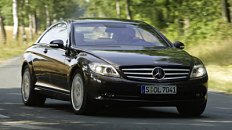 Being
the coupe version of S-class, Mercedes CL-class shares the same
underpinning platform, suspensions, powertrains, luxury and safety
equipments with the sedan. Although some 80mm has been chopped from the
wheelbase and 2 doors have been discarded, the CL is hardly any lighter
than S-class. In fact, for reasons only Mercedes knows, it is actually
55 kilograms heavier, so any hope for
superior performance or handling is entirely unrealistic. Being
the coupe version of S-class, Mercedes CL-class shares the same
underpinning platform, suspensions, powertrains, luxury and safety
equipments with the sedan. Although some 80mm has been chopped from the
wheelbase and 2 doors have been discarded, the CL is hardly any lighter
than S-class. In fact, for reasons only Mercedes knows, it is actually
55 kilograms heavier, so any hope for
superior performance or handling is entirely unrealistic.
Then
why are there still many people buy the CL ? well, because most people
love good-looking coupes. If you already have an S-class in your
garage, it won't be a bad idea to have a CL next to it. In this way,
you can let your wife
to drive the sedan and yourself to enjoy the niche image delivered by
the coupe. CL coupe is all about style. If it look
beautiful, it will be highly successful. If not, no one will buy it.
This matches my observation during the past 20 years – the most
successful CL in history is also the most beautiful CL of all, the C126
series running from 1981 to 1991 (remark: by then it was referred to
SEC instead of CL-class). A total of 74,000 units were sold. In
contrast, its successor, C140 series, sold only 26,000 coupes from
1992-98 because it looked so bulky and ugly. Then came the last
generation C215 series. It looked okay, more stylish than C140 but not
as graceful as C126, so 46,800 units were sold from 1999-2006.
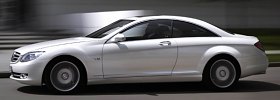 Having known that, one can
easily see
that Mercedes-Benz must work its best to design the new generation
CL, the C216 series. Is it successful ? mostly yes. Mercedes CL is very
different from
Bentley Continental GT, its slightly pricier arch-rival. Its styling is
feminine and civilized, in contrast to Bentley's classical and
muscular. The bumpers are not elegant enough (leaves room for
improvement to AMG?), but the sleek profile is quite attractive. The
banana-shaped side profile has some CLS in it. The large side windows
remain a classic feature of CL-class – thanks to the lack of B-pillars
and window frames, it delivers panoramic side view and an airy feel not
found in other coupes - what a contrast to the confined ambience in
Bentley Continental GT ! Having known that, one can
easily see
that Mercedes-Benz must work its best to design the new generation
CL, the C216 series. Is it successful ? mostly yes. Mercedes CL is very
different from
Bentley Continental GT, its slightly pricier arch-rival. Its styling is
feminine and civilized, in contrast to Bentley's classical and
muscular. The bumpers are not elegant enough (leaves room for
improvement to AMG?), but the sleek profile is quite attractive. The
banana-shaped side profile has some CLS in it. The large side windows
remain a classic feature of CL-class – thanks to the lack of B-pillars
and window frames, it delivers panoramic side view and an airy feel not
found in other coupes - what a contrast to the confined ambience in
Bentley Continental GT !
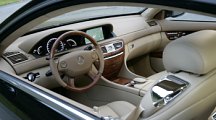 Inside,
some people may be disappointed that it shares the same conservative
dashboard with S-class. However, there is nothing wrong with the build
quality and materials, which is top notch. The same goes for the
massaging, air cushioning and ventilated front seats. Without doubt,
the front seats provide abundance of space all round so that no one can
complain. The rear seats are also the most accommodative in the coupe
world. This means a 6-footer can sit comfortably behind another
6-footer. Bentley can only dream about that. The Mercedes also offers
superior luxury equipments, such as a 4-zone climate control with individual
adjustment for each occupant, COMMAND in-car control / entertainment
system and PRE-SAFE system, which tightens seatbelts, closes windows
and even applies braking automatically in prior to collision. In terms
of
comfort and safety, no other coupes can match the CL. Inside,
some people may be disappointed that it shares the same conservative
dashboard with S-class. However, there is nothing wrong with the build
quality and materials, which is top notch. The same goes for the
massaging, air cushioning and ventilated front seats. Without doubt,
the front seats provide abundance of space all round so that no one can
complain. The rear seats are also the most accommodative in the coupe
world. This means a 6-footer can sit comfortably behind another
6-footer. Bentley can only dream about that. The Mercedes also offers
superior luxury equipments, such as a 4-zone climate control with individual
adjustment for each occupant, COMMAND in-car control / entertainment
system and PRE-SAFE system, which tightens seatbelts, closes windows
and even applies braking automatically in prior to collision. In terms
of
comfort and safety, no other coupes can match the CL.
 Mercedes offers two larger
engines from the S-class for serving the CL coupe – 388hp 5.5-liter V8
and
517hp twin-turbo 5.5-liter V12. They can propel CL500 (or CL550 in the
USA) and CL600 from zero to sixty mph in 5.2 seconds and 4.4 seconds
respectively. Unquestionably, CL600 is an autobahn rocket. It can
out-accelerate Porsche 911 Carrera S at any speed up to 155 mph, at
which point only the speed limiter deny it from the ultimate victory.
Nevertheless, the most sensible buy is CL500, whose large capacity V8
is torquey enough for effortless performance that most Mercedes drivers
ask for. Moreover, at £80,000, it falls in a position without any
direct competitors. In contrast, the £106,000 CL600 has to
compete head-on with the £118,000 Bentley Continental GT. The
CL600 might be faster, but the Bentley feels more special in its name
and craftsmanship. Mercedes offers two larger
engines from the S-class for serving the CL coupe – 388hp 5.5-liter V8
and
517hp twin-turbo 5.5-liter V12. They can propel CL500 (or CL550 in the
USA) and CL600 from zero to sixty mph in 5.2 seconds and 4.4 seconds
respectively. Unquestionably, CL600 is an autobahn rocket. It can
out-accelerate Porsche 911 Carrera S at any speed up to 155 mph, at
which point only the speed limiter deny it from the ultimate victory.
Nevertheless, the most sensible buy is CL500, whose large capacity V8
is torquey enough for effortless performance that most Mercedes drivers
ask for. Moreover, at £80,000, it falls in a position without any
direct competitors. In contrast, the £106,000 CL600 has to
compete head-on with the £118,000 Bentley Continental GT. The
CL600 might be faster, but the Bentley feels more special in its name
and craftsmanship.
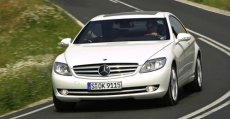 As expected, the CL is highly
refined in its running. The powertrain is smooth and barely audible.
Noise insulation is excellent. Ride quality scores top marks. Mercedes
once again successfully made its car ride like a magic carpet without
hurting handling, thanks to the second generation Active Body Control.
ABC uses adaptive hydraulic spring struts to increase suspension
stiffness during cornering. The second generation system reduces body
roll, pitch and dive even more effectively than the first generation,
resulting in a flat cornering. In twisty roads, you must be amazed that
the CL feels much more nimble than its 5-meters length and 2-ton weight
suggest. Nevertheless, it does not feel like a genuine sports coupe,
because the driving environment is detached from the road. The steering
is light and remote as it tries too hard to insulate road
irregularities from the driver's hands. The engine lacks emotion
compare with Italian coupes like Maserati 4200GT. The fool-proof
chassis lacks feedback to the driver. As expected, the CL is highly
refined in its running. The powertrain is smooth and barely audible.
Noise insulation is excellent. Ride quality scores top marks. Mercedes
once again successfully made its car ride like a magic carpet without
hurting handling, thanks to the second generation Active Body Control.
ABC uses adaptive hydraulic spring struts to increase suspension
stiffness during cornering. The second generation system reduces body
roll, pitch and dive even more effectively than the first generation,
resulting in a flat cornering. In twisty roads, you must be amazed that
the CL feels much more nimble than its 5-meters length and 2-ton weight
suggest. Nevertheless, it does not feel like a genuine sports coupe,
because the driving environment is detached from the road. The steering
is light and remote as it tries too hard to insulate road
irregularities from the driver's hands. The engine lacks emotion
compare with Italian coupes like Maserati 4200GT. The fool-proof
chassis lacks feedback to the driver.
However, Mercedes has never tried to make it a rival to Porsche 911,
BMW M6 or Ferrari 612 Scaglietti. The CL is designed to be a
comfortable grand tourer in the first hand. It does that job well and
deserves more success than its predecessor.
|
| The
above report was last updated on 19 Oct
2006. All Rights Reserved. |
|
CL63 AMG
|
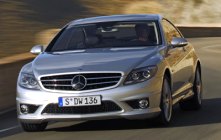 Though
CL600 is fast and refined, it lacks an emotional appeal. Firstly, its
styling is too feminine to car enthusiasts. Secondly, its twin-turbo
V12 sounds as flat as its torque curve. Thirdly, its chassis biases
towards the comfort side. That leaves plenty of room for AMG to
demonstrate its engineering and tuning know-how. At £105,000,
CL63 AMG asks for the same amount of money as CL600, but it satisfies
keen drivers much more than the regular version. This should earn it an extra
star in AutoZine's rating. Though
CL600 is fast and refined, it lacks an emotional appeal. Firstly, its
styling is too feminine to car enthusiasts. Secondly, its twin-turbo
V12 sounds as flat as its torque curve. Thirdly, its chassis biases
towards the comfort side. That leaves plenty of room for AMG to
demonstrate its engineering and tuning know-how. At £105,000,
CL63 AMG asks for the same amount of money as CL600, but it satisfies
keen drivers much more than the regular version. This should earn it an extra
star in AutoZine's rating.
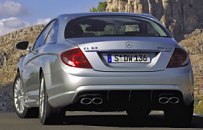 How can it do that? first of
all, let us see its clothes. By replacing the regular car's
unattractive bumpers with AMG's own design, aided with aggressive
aerodynamic skirts, diffusers, quad tailpipes and 19-inch, 16-spoke AMG
wheels, the civilized CL is suddenly converted into an edge-cutting
performance coupe. Although performance remains at the same level as
CL600, it looks stronger, faster and more purposeful. How can it do that? first of
all, let us see its clothes. By replacing the regular car's
unattractive bumpers with AMG's own design, aided with aggressive
aerodynamic skirts, diffusers, quad tailpipes and 19-inch, 16-spoke AMG
wheels, the civilized CL is suddenly converted into an edge-cutting
performance coupe. Although performance remains at the same level as
CL600, it looks stronger, faster and more purposeful.
Then comes the engine – AMG's 6.3-liter V8, already being used in
CLK63, E63 and CLS63. It produces 525 horsepower and 465 lbft in this
car, slightly more than other cars. Compare with CL600, CL63 AMG has a
slight advantage in horsepower and carries around 100 kilograms less
burden, but its naturally aspirated V8 is no where as torquey as the
5.5-liter twin-turbo V12. That's why Mercedes quoted the same
performance figures. In other words, it takes around 4.4 seconds to go
from rest to 60 mph and hit the electronic speed limiter at 155 mph,
although you can pay extra money to raise the limit to 186 mph.
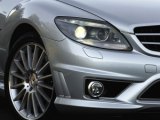 However, the advantage of the
AMG engine is not performance, but the subjective quality it delivers –
its eager and flexible character enables it to pull from as low as 1000
rpm and rev cleanly all the way to 7200 rpm, accompany with a gorgeous soundtrack
turning from melodious bass to thundering howl. With at least 80
percent of peak torque available from 2000 rpm upward, the drivers will
find little need to squeeze rev from the marvelous V8. But
unquestionably, they will deliberately do that a lot just to thrill
themselves. However, the advantage of the
AMG engine is not performance, but the subjective quality it delivers –
its eager and flexible character enables it to pull from as low as 1000
rpm and rev cleanly all the way to 7200 rpm, accompany with a gorgeous soundtrack
turning from melodious bass to thundering howl. With at least 80
percent of peak torque available from 2000 rpm upward, the drivers will
find little need to squeeze rev from the marvelous V8. But
unquestionably, they will deliberately do that a lot just to thrill
themselves.
AMG has reprogrammed the 7G-Tronic gearbox and Active Body Control to
offer 3 driving modes – Comfort is equivalent to the standard CL; Sport
enables 30% quicker gearshifts and stiffer suspensions; Manual allows
50% quicker gearshifts via paddles as well as the stiffest suspension
setting. They also alter throttle response of the engine. In Sport and
Manual mode, the CL63 handles sharper and corners even flatter than the
standard car. Inevitably, ride quality suffers a little over low speed
bumps, but running on highway there is no discernible difference from
the standard car. It remains to be one of the most comfortable rides in
the grand tourer segment.
 Even though the car weighs 2
tons, braking performance is sensational, thanks to the upgrade to
ceramic composite discs, measuring 390mm up front and 365mm at the
rear, plus twin-sliding front calipers to reduce heat dissipation to
the brake fluid. AMG always does braking job better than the M division
of BMW. CL63 is no exception when compares with BMW M6. Its braking is
more powerful and fade-free. Even though the car weighs 2
tons, braking performance is sensational, thanks to the upgrade to
ceramic composite discs, measuring 390mm up front and 365mm at the
rear, plus twin-sliding front calipers to reduce heat dissipation to
the brake fluid. AMG always does braking job better than the M division
of BMW. CL63 is no exception when compares with BMW M6. Its braking is
more powerful and fade-free.
The only downside of the car is steering. Although the on-center
weighting has been increased to inspire confidence, push it into
corners and the weighting remains constant regardless of cornering
force. In other words, there is no much feedback from the steering to
tell the driver how close it gets within cornering limit. Perhaps
because the Active Body Control artificially resists body roll and
keeps the wheels vertical, the front wheels remain well contact with
the road thus there is no change of steering weighting until ABC gives
up resisting. This mean, while CL63 AMG can beat Bentley Continental GT
for driver appeal, it is not in the league of Ferrari 612 Scaglietti.
|
| The
above report was last updated on 19 Oct 2006. All Rights Reserved. |
|
CL65 AMG
|
 AMG's 6.0-liter
twin-turbo V12 started
life in the last generation CL-class and since then spread to other big
Mercedes. Its roots can be traced back to the outgoing Mercedes
5.8-liter sohc V12 that debuted in 1999. Despite of the rather outdated
3 valves per cylinder design, the addition of two turbochargers and
structural strengthening resulting in 612 reliable horsepower and an
even more astonishing torque of 737 pound-foot (or 1000 Nm). The latter
is available from 2000 rpm all the way to 4000 rpm. It gave the
outgoing CL65, S65 and SL65 supercar performance and luxury car
refinement simultaneously. The engine is so perfect that Mercedes and
AMG found no need to improve it further. AMG's 6.0-liter
twin-turbo V12 started
life in the last generation CL-class and since then spread to other big
Mercedes. Its roots can be traced back to the outgoing Mercedes
5.8-liter sohc V12 that debuted in 1999. Despite of the rather outdated
3 valves per cylinder design, the addition of two turbochargers and
structural strengthening resulting in 612 reliable horsepower and an
even more astonishing torque of 737 pound-foot (or 1000 Nm). The latter
is available from 2000 rpm all the way to 4000 rpm. It gave the
outgoing CL65, S65 and SL65 supercar performance and luxury car
refinement simultaneously. The engine is so perfect that Mercedes and
AMG found no need to improve it further.
As a result, the new generation CL65 AMG is the combination of new
chassis and old engine. Its acceleration is as strong as the last car,
that means 0-60 mph in 4.3 seconds and 0-100 mph in under 9 seconds.
Once its traction control overcame the initial wheel spin, its rocket
acceleration could embarrass many supercars like Lamborghini Gallardo
and Porsche 911 Turbo. If you find ways to de-restrict its speed
limiter, you might find it capable to reach 212 mph, some 20 mph faster
than those supercars ! Admittedly, its £150,000 price also
exceeds those cars.
 The new generation CL chassis is stronger and more agile
than the old car. The uprated power steering gets heavier and more
responsive. The brakes become more powerful. However, in twisty roads
you can still tell this is a 2-ton-plus big car from the inertia felt
up front and the frequent intervention of ESP stability control. When
it turns into a corner, it doesn't have the same eagerness and
precision as the well balanced Ferrari 612 Scaglietti. Its steering
isn't as communicative. Its artificial roll resistance from ABC robs
the driver of the sense of cornering limit. The remote feeling prevents
it from inspiring its driver as well as its performance suggested. The new generation CL chassis is stronger and more agile
than the old car. The uprated power steering gets heavier and more
responsive. The brakes become more powerful. However, in twisty roads
you can still tell this is a 2-ton-plus big car from the inertia felt
up front and the frequent intervention of ESP stability control. When
it turns into a corner, it doesn't have the same eagerness and
precision as the well balanced Ferrari 612 Scaglietti. Its steering
isn't as communicative. Its artificial roll resistance from ABC robs
the driver of the sense of cornering limit. The remote feeling prevents
it from inspiring its driver as well as its performance suggested.
As we always know, the CL65 is the king of Autobahn rather than a
versatile sporting car. This is true to the old car, to all other AMG
products and continues to apply to the new CL65 AMG. Its super
performance, its seamless automatic transmission, its absorbent ride
and its remarkable directional stability work best on unrestricted
highway. As long as in Autobahn, no one else could threaten it.
|
| The
above report was last updated on 22 Jun 2007. All Rights Reserved. |
|
CL500 biturbo and CL63 AMG biturbo
|

|
CL500 drinks and emits 22 percent less
than the old car...
|
Subtly revised fascia,
headlamps, bumper intakes and a more contoured bonnet are what we can
distinguish the latest Mercedes CL coupe from the previous one.
However, the most significant revelation is the wordings located just
behind the front wheel arches – V8
Biturbo. Yes, Mercedes has joined the trend of downsized
turbocharged motors in a bid to cut carbon-dioxide emission
drastically. So the motor lying under the bonnet of CL500 is downsized
from 5461 cc to 4663 cc. It's a completely new motor, as implied by its
codename M278 instead of the old M273. Twin-variable cam phasing,
direct fuel injection and twin-turbo are key improvements. Others like
low-friction pistons, on-demand oil / cooling pumps, on-demand
alternator and auto stop-start also help making it more efficient.
Overall, the CL500 drinks and emits 22 percent less than the old car,
an impressive progress considering the rest of the car is basically
unchanged.
The beauty of a smaller turbocharged motor is, when you need, it can
pump out superior horsepower and mountains of torque from very low rpm.
That is exactly the case of M278. It produces 435 hp instead of the
previous 388 hp, and as much as 516 lb-ft of torque from merely 1800 to
3500 rpm. The old car ? just 391 lb-ft, and that needed 2800 rpm to
realize. At 2000 rpm, the new Biturbo motor produces 45 percent more
torque than the old V8. No wonder on the road the CL500 feels
significantly stronger. 0-60 mph is reached in 4.7 seconds, half a
second quicker than before. Rolling acceleration is even more
impressive, as it is instantaneous without the need of gathering rev.
The turbocharged V8 still loves to rev if you ask it to do so, but
otherwise it rarely needs to rev beyond the mid-range. No wonder it is
considerably smoother and quieter.
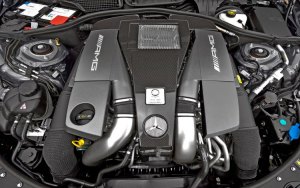 |
No matter how hard AMG worked, it
still failed to replicate the addictive full song of the 6.2-liter on
the new biturbo engine...
|
While the turbo conversion of CL500 is
by all means successful, the same cannot be said to the case of CL63
AMG. It doesn't mean the new AMG M157 engine is any weaker or laggier
than the old M156. On the contrary, the 5.5-liter direct-injected
biturbo V8 is more powerful, massively more torquey from bottom end to
mid-range and virtually free of turbo lag. It is also 25 percent
greener than the old 6.2-liter naturally aspirated V8. In standard
trim, it produces 544 hp and 590 lb-ft of torque from 2000-4000 rpm,
easily eclipsing the old engine's 525 hp and 465 lb-ft at 5200 rpm.
With performance pack selected, its engine management system even lifts
turbo boost limit from 1.0 to 1.3 bar, producing 571 hp and 664 lb-ft.
Moreover, the new engine is now mated to the 7-speed MCT gearbox
previously reserved for SL63 AMG. Its combination of automatic gearbox
and multi-plate clutch (instead of torque converter) makes gearshifts
quicker and more satisfying. All these factors should mean a better
car.
Unfortunately, we love the aural quality of the 6.2-liter too much. No
matter how hard AMG worked, it still failed to replicate the addictive
full song of the 6.2-liter on the new biturbo engine. By the standard
of turbocharged motors, this one sings very well indeed. It merges the
turbochargers' background bass with hard-edged exhaust note
beautifully. However, it is still no match with the thundering 6.2 for
that urgency at high rpm. A similar story can be said to its throttle
response, which can't quite match the naturally aspirated engine.

|
Its superiority lies on mid-range
acceleration, where the tremendous torque tells a big difference.
|
Limited by traction, the new CL63 does not accelerate from
zero to 60 mph much faster than the old car (see spec. below for
comparison). Its superiority lies on mid-range acceleration, where the
tremendous torque tells a big difference. Of course, you may argue
whether it really needs that extra performance when the old CL63 was
already very quick. From another viewpoint, it doesn't hurt to get that
extra performance when fuel consumption and emission are simultaneously
reduced by 25 percent. Perhaps the slight loss of aural excitement is
worth paying for.
The last updated model is CL65 AMG. Its twin-turbo V12 has been tweaked
from 612 to 630 hp, although its 1000Nm of torque is still limited by
the old 5-speed auto. 0-60 mph performance is barely improved by a
tenth of a second to 4.2. Note that the CL63 with performance pack is
only 0.1 sec behind. It can easily substitute the position of CL65.
It's not a secret that the CL65 is going to phase out soon. Now it is
only built to orders.
|
| The
above report was last updated on 30 Oct 2010. All Rights Reserved. |
| Specifications
|
| General remarks |
| Layout |
| Chassis |
| Body |
| Length / width / height |
| Wheelbase |
| Engine |
| Capacity |
| Valve gears |
| Induction |
| Other engine features |
| Max power |
| Max torque |
| Transmission |
Suspension layout
|
| Suspension features |
Tires
|
| Kerb weight |
| Top speed |
| 0-60 mph (sec) |
| 0-100 mph (sec) |
|
| CL500 (2006) |
Front-engined, RWD
|
| Steel monocoque |
| Mainly steel |
| 5065 / 1871 / 1418 mm |
| 2955 mm |
V8, 90-degree
|
| 5461 cc |
DOHC 32 valves, VVT
|
| VIM |
| - |
388 hp
|
391 lbft
|
| 7-speed automatic |
F: 4-link
R: multi-link
|
Active body control
|
245/45ZR18
|
| 1920 kg |
| 155 mph (limited) |
5.2 (c)
|
| - |
|
| CL600 (2006) |
Front-engined, RWD
|
| Steel monocoque |
| Mainly steel |
| 5065 / 1871 / 1418 mm |
| 2955 mm |
V12, 60-degree
|
| 5513 cc |
SOHC 36 valves
|
| Twin-turbo |
| Twin-spark |
517 hp
|
612 lbft
|
| 5-speed automatic |
F: 4-link
R: multi-link
|
Active body control
|
F: 255/45ZR18
R: 275/45ZR18 |
| 2110 kg |
| 155 mph (limited) |
4.4 (c) / 4.3* / 4.1**
|
10.1* / 9.6**
|
|
| CL63 AMG (2006) |
Front-engined, RWD
|
| Steel monocoque |
| Mainly steel |
| 5065 / 1871 / 1418 mm |
| 2955 mm |
V8, 90-degree
|
| 6208 cc |
DOHC 32 valves, DVVT
|
| VIM |
| - |
525 hp
|
465 lbft
|
| 7-speed automatic |
F: 4-link
R: multi-link
|
Active body control
|
F: 255/40ZR19
R: 275/40ZR19 |
| 2010 kg |
| 155 mph (limited) |
4.4 (c) / 4.3*
|
10.2*
|
|
|
|
|
|
| General remarks |
| Layout |
| Chassis |
| Body |
| Length / width / height |
| Wheelbase |
| Engine |
| Capacity |
| Valve gears |
| Induction |
| Other engine features |
| Max power |
| Max torque |
| Transmission |
Suspension layout
|
| Suspension features |
Tires
|
| Kerb weight |
| Top speed |
| 0-60 mph (sec) |
| 0-100 mph (sec) |
|
| CL65 AMG (2007) |
Front-engined, RWD
|
| Steel monocoque |
| Mainly steel |
| 5065 / 1871 / 1418 mm |
| 2955 mm |
V12, 60-degree
|
| 5980 cc |
SOHC 36 valves
|
| Twin-turbo |
| Twin-spark |
612 hp
|
738 lbft
|
| 5-speed automatic |
F: 4-link
R: multi-link
|
Active body control
|
F: 255/35ZR20
R: 275/35ZR20 |
| 2165 kg |
| 155 mph (limited) |
4.3 (c)
|
-
|
|
| CL500 (2010) |
Front-engined, RWD
|
| Steel monocoque |
| Mainly steel |
| 5035 / 1871 / 1419 mm |
| 2955 mm |
V8, 90-degree
|
| 4663 cc |
DOHC 32 valves, DVVT
|
| Twin-turbo |
| DI |
435 hp
|
516 lbft
|
| 7-speed automatic |
F: 4-link
R: multi-link
|
Active body control
|
F: 255/45ZR18
R: 275/45ZR18
|
| 1995 kg |
| 155 mph (limited) |
4.7 (c)
|
| - |
|
| CL63 AMG Perform (2010) |
Front-engined, RWD
|
| Steel monocoque |
| Mainly steel |
| 5106 / 1871 / 1426 mm |
| 2955 mm |
V8, 90-degree
|
| 5461 cc |
DOHC 32 valves, DVVT
|
| Twin-turbo |
| DI |
571 hp
|
664 lbft
|
| 7-speed MCT |
F: 4-link
R: multi-link
|
Active body control
|
F: 255/40ZR19
R: 275/40ZR19
|
| 2060 kg |
| 186 mph (limited) |
4.3 (c) / 4.0* / 3.9**
|
| 8.8* / 8.7** |
|
|
|
|
|
| General remarks |
| Layout |
| Chassis |
| Body |
| Length / width / height |
| Wheelbase |
| Engine |
| Capacity |
| Valve gears |
| Induction |
| Other engine features |
| Max power |
| Max torque |
| Transmission |
Suspension layout
|
| Suspension features |
Tires
|
| Kerb weight |
| Top speed |
| 0-60 mph (sec) |
| 0-100 mph (sec) |
|
| CL65 AMG (2010) |
Front-engined, RWD
|
| Steel monocoque |
| Mainly steel |
| 5106 / 1871 / 1426 mm |
| 2955 mm |
V12, 60-degree
|
| 5980 cc |
SOHC 36 valves
|
| Twin-turbo |
| Twin-spark |
630 hp
|
738 lbft
|
| 5-speed automatic |
F: 4-link
R: multi-link
|
Active body control
|
F: 255/35ZR20
R: 275/35ZR20 |
| 2170 kg |
| 186 mph (limited) |
4.2 (c) / 4.5*
|
9.2*
|
|
|
|
|
|
|
|
|
| Performance
tested by: *C&D,
**R&T |
Copyright©
1997-2010
by Mark Wan @ AutoZine
|
|
|
 Being
the coupe version of S-class, Mercedes CL-class shares the same
underpinning platform, suspensions, powertrains, luxury and safety
equipments with the sedan. Although some 80mm has been chopped from the
wheelbase and 2 doors have been discarded, the CL is hardly any lighter
than S-class. In fact, for reasons only Mercedes knows, it is actually
55 kilograms heavier, so any hope for
superior performance or handling is entirely unrealistic.
Being
the coupe version of S-class, Mercedes CL-class shares the same
underpinning platform, suspensions, powertrains, luxury and safety
equipments with the sedan. Although some 80mm has been chopped from the
wheelbase and 2 doors have been discarded, the CL is hardly any lighter
than S-class. In fact, for reasons only Mercedes knows, it is actually
55 kilograms heavier, so any hope for
superior performance or handling is entirely unrealistic.  Having known that, one can
easily see
that Mercedes-Benz must work its best to design the new generation
CL, the C216 series. Is it successful ? mostly yes. Mercedes CL is very
different from
Bentley Continental GT, its slightly pricier arch-rival. Its styling is
feminine and civilized, in contrast to Bentley's classical and
muscular. The bumpers are not elegant enough (leaves room for
improvement to AMG?), but the sleek profile is quite attractive. The
banana-shaped side profile has some CLS in it. The large side windows
remain a classic feature of CL-class – thanks to the lack of B-pillars
and window frames, it delivers panoramic side view and an airy feel not
found in other coupes - what a contrast to the confined ambience in
Bentley Continental GT !
Having known that, one can
easily see
that Mercedes-Benz must work its best to design the new generation
CL, the C216 series. Is it successful ? mostly yes. Mercedes CL is very
different from
Bentley Continental GT, its slightly pricier arch-rival. Its styling is
feminine and civilized, in contrast to Bentley's classical and
muscular. The bumpers are not elegant enough (leaves room for
improvement to AMG?), but the sleek profile is quite attractive. The
banana-shaped side profile has some CLS in it. The large side windows
remain a classic feature of CL-class – thanks to the lack of B-pillars
and window frames, it delivers panoramic side view and an airy feel not
found in other coupes - what a contrast to the confined ambience in
Bentley Continental GT !  Inside,
some people may be disappointed that it shares the same conservative
dashboard with S-class. However, there is nothing wrong with the build
quality and materials, which is top notch. The same goes for the
massaging, air cushioning and ventilated front seats. Without doubt,
the front seats provide abundance of space all round so that no one can
complain. The rear seats are also the most accommodative in the coupe
world. This means a 6-footer can sit comfortably behind another
6-footer. Bentley can only dream about that. The Mercedes also offers
superior luxury equipments, such as a 4-zone climate control with individual
adjustment for each occupant, COMMAND in-car control / entertainment
system and PRE-SAFE system, which tightens seatbelts, closes windows
and even applies braking automatically in prior to collision. In terms
of
comfort and safety, no other coupes can match the CL.
Inside,
some people may be disappointed that it shares the same conservative
dashboard with S-class. However, there is nothing wrong with the build
quality and materials, which is top notch. The same goes for the
massaging, air cushioning and ventilated front seats. Without doubt,
the front seats provide abundance of space all round so that no one can
complain. The rear seats are also the most accommodative in the coupe
world. This means a 6-footer can sit comfortably behind another
6-footer. Bentley can only dream about that. The Mercedes also offers
superior luxury equipments, such as a 4-zone climate control with individual
adjustment for each occupant, COMMAND in-car control / entertainment
system and PRE-SAFE system, which tightens seatbelts, closes windows
and even applies braking automatically in prior to collision. In terms
of
comfort and safety, no other coupes can match the CL. Mercedes offers two larger
engines from the S-class for serving the CL coupe – 388hp 5.5-liter V8
and
517hp twin-turbo 5.5-liter V12. They can propel CL500 (or CL550 in the
USA) and CL600 from zero to sixty mph in 5.2 seconds and 4.4 seconds
respectively. Unquestionably, CL600 is an autobahn rocket. It can
out-accelerate Porsche 911 Carrera S at any speed up to 155 mph, at
which point only the speed limiter deny it from the ultimate victory.
Nevertheless, the most sensible buy is CL500, whose large capacity V8
is torquey enough for effortless performance that most Mercedes drivers
ask for. Moreover, at £80,000, it falls in a position without any
direct competitors. In contrast, the £106,000 CL600 has to
compete head-on with the £118,000 Bentley Continental GT. The
CL600 might be faster, but the Bentley feels more special in its name
and craftsmanship.
Mercedes offers two larger
engines from the S-class for serving the CL coupe – 388hp 5.5-liter V8
and
517hp twin-turbo 5.5-liter V12. They can propel CL500 (or CL550 in the
USA) and CL600 from zero to sixty mph in 5.2 seconds and 4.4 seconds
respectively. Unquestionably, CL600 is an autobahn rocket. It can
out-accelerate Porsche 911 Carrera S at any speed up to 155 mph, at
which point only the speed limiter deny it from the ultimate victory.
Nevertheless, the most sensible buy is CL500, whose large capacity V8
is torquey enough for effortless performance that most Mercedes drivers
ask for. Moreover, at £80,000, it falls in a position without any
direct competitors. In contrast, the £106,000 CL600 has to
compete head-on with the £118,000 Bentley Continental GT. The
CL600 might be faster, but the Bentley feels more special in its name
and craftsmanship.  As expected, the CL is highly
refined in its running. The powertrain is smooth and barely audible.
Noise insulation is excellent. Ride quality scores top marks. Mercedes
once again successfully made its car ride like a magic carpet without
hurting handling, thanks to the second generation Active Body Control.
ABC uses adaptive hydraulic spring struts to increase suspension
stiffness during cornering. The second generation system reduces body
roll, pitch and dive even more effectively than the first generation,
resulting in a flat cornering. In twisty roads, you must be amazed that
the CL feels much more nimble than its 5-meters length and 2-ton weight
suggest. Nevertheless, it does not feel like a genuine sports coupe,
because the driving environment is detached from the road. The steering
is light and remote as it tries too hard to insulate road
irregularities from the driver's hands. The engine lacks emotion
compare with Italian coupes like Maserati 4200GT. The fool-proof
chassis lacks feedback to the driver.
As expected, the CL is highly
refined in its running. The powertrain is smooth and barely audible.
Noise insulation is excellent. Ride quality scores top marks. Mercedes
once again successfully made its car ride like a magic carpet without
hurting handling, thanks to the second generation Active Body Control.
ABC uses adaptive hydraulic spring struts to increase suspension
stiffness during cornering. The second generation system reduces body
roll, pitch and dive even more effectively than the first generation,
resulting in a flat cornering. In twisty roads, you must be amazed that
the CL feels much more nimble than its 5-meters length and 2-ton weight
suggest. Nevertheless, it does not feel like a genuine sports coupe,
because the driving environment is detached from the road. The steering
is light and remote as it tries too hard to insulate road
irregularities from the driver's hands. The engine lacks emotion
compare with Italian coupes like Maserati 4200GT. The fool-proof
chassis lacks feedback to the driver. Though
CL600 is fast and refined, it lacks an emotional appeal. Firstly, its
styling is too feminine to car enthusiasts. Secondly, its twin-turbo
V12 sounds as flat as its torque curve. Thirdly, its chassis biases
towards the comfort side. That leaves plenty of room for AMG to
demonstrate its engineering and tuning know-how. At £105,000,
CL63 AMG asks for the same amount of money as CL600, but it satisfies
keen drivers much more than the regular version. This should earn it an extra
star in AutoZine's rating.
Though
CL600 is fast and refined, it lacks an emotional appeal. Firstly, its
styling is too feminine to car enthusiasts. Secondly, its twin-turbo
V12 sounds as flat as its torque curve. Thirdly, its chassis biases
towards the comfort side. That leaves plenty of room for AMG to
demonstrate its engineering and tuning know-how. At £105,000,
CL63 AMG asks for the same amount of money as CL600, but it satisfies
keen drivers much more than the regular version. This should earn it an extra
star in AutoZine's rating. How can it do that? first of
all, let us see its clothes. By replacing the regular car's
unattractive bumpers with AMG's own design, aided with aggressive
aerodynamic skirts, diffusers, quad tailpipes and 19-inch, 16-spoke AMG
wheels, the civilized CL is suddenly converted into an edge-cutting
performance coupe. Although performance remains at the same level as
CL600, it looks stronger, faster and more purposeful.
How can it do that? first of
all, let us see its clothes. By replacing the regular car's
unattractive bumpers with AMG's own design, aided with aggressive
aerodynamic skirts, diffusers, quad tailpipes and 19-inch, 16-spoke AMG
wheels, the civilized CL is suddenly converted into an edge-cutting
performance coupe. Although performance remains at the same level as
CL600, it looks stronger, faster and more purposeful.  However, the advantage of the
AMG engine is not performance, but the subjective quality it delivers –
its eager and flexible character enables it to pull from as low as 1000
rpm and rev cleanly all the way to 7200 rpm, accompany with a gorgeous soundtrack
turning from melodious bass to thundering howl. With at least 80
percent of peak torque available from 2000 rpm upward, the drivers will
find little need to squeeze rev from the marvelous V8. But
unquestionably, they will deliberately do that a lot just to thrill
themselves.
However, the advantage of the
AMG engine is not performance, but the subjective quality it delivers –
its eager and flexible character enables it to pull from as low as 1000
rpm and rev cleanly all the way to 7200 rpm, accompany with a gorgeous soundtrack
turning from melodious bass to thundering howl. With at least 80
percent of peak torque available from 2000 rpm upward, the drivers will
find little need to squeeze rev from the marvelous V8. But
unquestionably, they will deliberately do that a lot just to thrill
themselves. Even though the car weighs 2
tons, braking performance is sensational, thanks to the upgrade to
ceramic composite discs, measuring 390mm up front and 365mm at the
rear, plus twin-sliding front calipers to reduce heat dissipation to
the brake fluid. AMG always does braking job better than the M division
of BMW. CL63 is no exception when compares with BMW M6. Its braking is
more powerful and fade-free.
Even though the car weighs 2
tons, braking performance is sensational, thanks to the upgrade to
ceramic composite discs, measuring 390mm up front and 365mm at the
rear, plus twin-sliding front calipers to reduce heat dissipation to
the brake fluid. AMG always does braking job better than the M division
of BMW. CL63 is no exception when compares with BMW M6. Its braking is
more powerful and fade-free. AMG's 6.0-liter
twin-turbo V12 started
life in the last generation CL-class and since then spread to other big
Mercedes. Its roots can be traced back to the outgoing Mercedes
5.8-liter sohc V12 that debuted in 1999. Despite of the rather outdated
3 valves per cylinder design, the addition of two turbochargers and
structural strengthening resulting in 612 reliable horsepower and an
even more astonishing torque of 737 pound-foot (or 1000 Nm). The latter
is available from 2000 rpm all the way to 4000 rpm. It gave the
outgoing CL65, S65 and SL65 supercar performance and luxury car
refinement simultaneously. The engine is so perfect that Mercedes and
AMG found no need to improve it further.
AMG's 6.0-liter
twin-turbo V12 started
life in the last generation CL-class and since then spread to other big
Mercedes. Its roots can be traced back to the outgoing Mercedes
5.8-liter sohc V12 that debuted in 1999. Despite of the rather outdated
3 valves per cylinder design, the addition of two turbochargers and
structural strengthening resulting in 612 reliable horsepower and an
even more astonishing torque of 737 pound-foot (or 1000 Nm). The latter
is available from 2000 rpm all the way to 4000 rpm. It gave the
outgoing CL65, S65 and SL65 supercar performance and luxury car
refinement simultaneously. The engine is so perfect that Mercedes and
AMG found no need to improve it further. The new generation CL chassis is stronger and more agile
than the old car. The uprated power steering gets heavier and more
responsive. The brakes become more powerful. However, in twisty roads
you can still tell this is a 2-ton-plus big car from the inertia felt
up front and the frequent intervention of ESP stability control. When
it turns into a corner, it doesn't have the same eagerness and
precision as the well balanced Ferrari 612 Scaglietti. Its steering
isn't as communicative. Its artificial roll resistance from ABC robs
the driver of the sense of cornering limit. The remote feeling prevents
it from inspiring its driver as well as its performance suggested.
The new generation CL chassis is stronger and more agile
than the old car. The uprated power steering gets heavier and more
responsive. The brakes become more powerful. However, in twisty roads
you can still tell this is a 2-ton-plus big car from the inertia felt
up front and the frequent intervention of ESP stability control. When
it turns into a corner, it doesn't have the same eagerness and
precision as the well balanced Ferrari 612 Scaglietti. Its steering
isn't as communicative. Its artificial roll resistance from ABC robs
the driver of the sense of cornering limit. The remote feeling prevents
it from inspiring its driver as well as its performance suggested.

